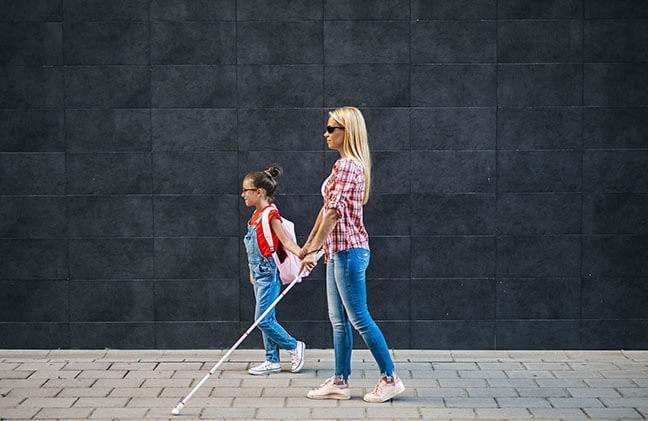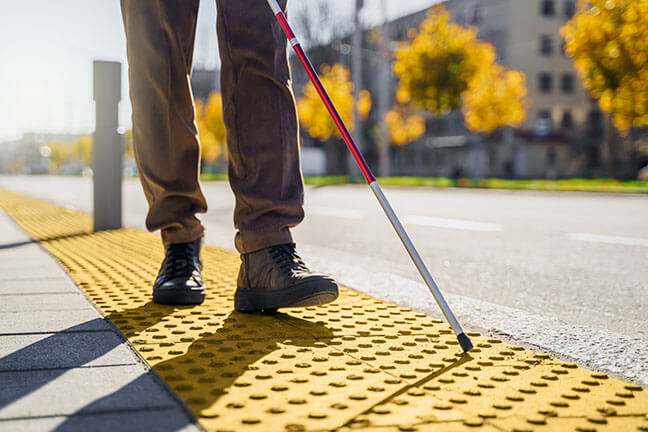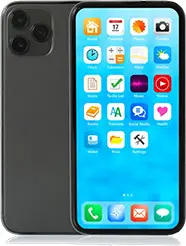Losing your vision can make daily life incredibly difficult. However financial assistance is available to the blind and visually impaired through various disability benefits programs. This guide will explain key benefits like SSDI and SSI and other Federal, state and local support.
Read on to understand program eligibility, navigate the application process, and access free wireless service. With strong medical documentation and persistence, you can get approved for essential disability funding.
What is Considered Legally Blind?
The first step is understanding definitions of vision loss. Legal blindness generally means:
- Corrected central vision of 20/200 or worse in your better eye.
- Visual field of 20 degrees or less in your better eye.
So even with glasses or contacts, you can only see at 20 feet what a person with normal vision sees at 200 feet. You also have very limited peripheral vision.
Partial sight still poses challenges and costs. But if measurements fall below legal blindness thresholds, you can potentially qualify for disability benefits.
Comparing SSDI and SSI Disability Programs
Two main federal disability options from the Social Security Administration to assist legally blind individuals are:
Social Security Disability Insurance (SSDI)
SSDI pays monthly benefits to blind adults with a work history who paid Social Security taxes. The average SSDI payment is $800 – $2,000 per month. You must be unable to work for 12+ months. After a 24-month waiting period, you also receive Medicare.
Supplemental Security Income (SSI)
SSI provides financial and medical assistance to blind children and adults with limited income and resources. Payments average $600 – $800 monthly. There is no work requirement.

How to Apply for SSI and SSDI Benefits
You can apply for SSI and SSDI benefits in the following ways:
SSI Application:
- In person at your local Social Security office. You’ll need to schedule an appointment for an interview with a Social Security representative.
- By phone – you can call 1-800-772-1213 to begin the SSI application process over the phone.
- Online – you can start your application at www.ssa.gov/benefits/ssi but will need to follow up in person.
SSDI Application:
- Online at www.ssa.gov/applyfordisability – you can complete the entire SSDI application process through the SSA website.
- By phone – call 1-800-772-1213 to apply for SSDI over the phone.
- In person at a local Social Security office. Make an appointment to apply in-person.
- By mail – request an Application for Social Security Disability Benefits form and mail it back to your local office.
Key notes:
- For SSI benefits, an in-person interview is required but you can start online/phone.
- The full SSDI application can be done online, by phone, mail, or in the office.
- You’ll follow up by providing medical and financial documentation.
- You can apply for both programs at the same time if eligible.
Prepare Medical Records
- Vision tests showing acuity and field of vision percentages.
- Exam and treatment history documenting progression over time.
- Doctor statements affirming severity, limitations, and inability to work.
Include Detailed Background Information
- Work history, education, training credentials.
- Household income/resources like bank statements.
- Contact info for all medical providers.
File claims promptly and appeal any denials. Consider hiring an expert disability lawyer for guidance.

The Path to Maintaining Financial Stability
If approved for SSDI benefits, you can earn higher incomes than non-blind individuals before benefits are reduced. Ensure you accurately report earnings and work activity. Various programs also help blind people train for jobs or return to work.
Other Ways to Get Help for Blindness
Along with SSDI and SSI, other assistance includes:
- VA disability benefits for visually impaired veterans.
- Vocational rehab and workplace accommodations.
- State pensions, tax credits, and exemptions for the blind.
- Medicaid, SNAP, and housing subsidies based on need.
- Lifeline and Affordable Connectivity Program
Getting VA Disability Benefits for Vision Loss
The Department of Veterans Affairs (VA) provides disability compensation to veterans who have conditions related to their military service. Impaired vision is one such qualifying condition.
VA disability benefits for blindness or visual impairment include:
- Monthly tax-free compensation based on your rated level of disability.
- Additional allowances if you have dependents.
- Free vision care and prescription eyeglasses through VA medical centers.
- Access to assistive technologies like audiobooks and screen readers.
- Vision insurance to cover civilian providers if needed.
- Access to rehabilitation programs for independent living skills and workplace accommodations.
To qualify for VA vision loss benefits, you must:
- Have a service-connected visual impairment rated at least 10% disabling. Higher ratings result in increased compensation.
- Have an honorable or general discharge from military service.
- Submit medical records and eye exams documenting your visual acuity, field of vision loss, and related functional impacts.
- Be able to link your vision disability to an event, injury, or circumstance related to your time in service.
Veterans with low vision or those who are legally blind receive priority access to VA health services. Speak to a VA representative to file a claim and get connected to benefits that can aid recovery from loss of visual, and daily functioning.

Getting FREE Wireless Service Through the Lifeline and ACP Programs
If you’re blind or have low vision, FREE wireless service can help you stay connected, independent and eliminate your monthly cell phone and broadband bills. EASY Wireless is a wireless provider offering totally free cell phone plans to qualifying households through two government benefit programs:
Lifeline Program
The Lifeline program provides discounted phone and internet services to qualifying low-income consumers. Administered by the FCC, Lifeline provides up to $9.25 monthly in subsidies that eligible households can use to reduce the cost of home internet, mobile phone plans, or bundled voice-data packages.
How to Qualify for Lifeline
You may already qualify if you are enrolled in one of the following government programs:
- Supplemental Nutrition Assistance Program (SNAP)
- Medicaid
- Supplemental Security Income (SSI)
- Federal Public Housing Assistance (FPHA)
- Veterans and Survivors Pension Benefit
Qualify for Tribal Lifeline
You may qualify for benefits if you live on federally recognized Tribal lands and take part in one of the following Tribal government programs:
- Bureau of Indian Affairs (BIA) General Assistance
- Tribally Administered Temporary Assistance for Needy Families (TANF)
- Tribal Head Start
- Food Distribution Program on Indian Reservations
You can also qualify by income if your household income is under 135% of the Federal Poverty Line.
Affordable Connectivity Program (ACP)
The Affordable Connectivity Program (ACP) was established in 2021 as part of the bipartisan Infrastructure Investment and Jobs Act. It replaced and improved upon the previous Lifeline subsidy known as the Emergency Broadband Benefit.
ACP offers up to $30 off internet bills for eligible households. Approximately 40% of U.S. households qualify for this program.
Qualifying Programs for ACP Benefits
- All Lifeline Programs
- Is approved to receive benefits under the free and reduced-price school lunch program or the school breakfast program
- Received a Pell Grant during the current award year
You can also qualify by income if your household income is under 200% of the Federal Poverty Line.
When you apply, combine both your Lifeline and ACP benefits to receive:
EASY Wireless Unlimited Plan
- FREE Unlimited Data
- FREE Unlimited Talk
- FREE Unlimited Text
- FREE SIM Card Kit and Activation
- Choose to Keep Your Number or Get a New One
- Access to the same National Coverage as the Major Carriers (without the expense)
Apply Online
Apply in only minutes through our convenient online portal.
EASY Wireless understands the needs of the sight-loss community and utilize special plugins to assist you through the application process.
Once you qualify and we’ll ship your SIM Card Kit right to your door, free-of-charge!
Just enter your email and zip code in the box below and click “Enroll Now” to get started.
Losing your vision can feel isolating, but many organizations provide community, training, and assistance to help the blind thrive. Take advantage of free wireless service to conveniently access these vital resources.
Local Community Centers
- Independent living centers offer classes, counseling, assistive tech help, accessibility advice, and social events.
- Adult blindness skills training programs provide instruction on daily living activities.
- Support groups connect those experiencing similar challenges for sharing practical tips and emotional encouragement.
- Low vision clinics and eye doctors can recommend local resources.
National Blindness Associations
- American Council of the Blind provides advocacy, scholarships, events and a supportive community.
- National Federation of the Blind has state affiliates, programs, accessible book libraries, and more.
- American Foundation for the Blind offers personalized services, assistive devices, workplace help, and research.
Government and Nonprofit Agencies
- State vocational rehabilitation agencies assist with job training and workplace accommodations.
- The Library of Congress National Library Service for the Blind and Print Disabled provides free braille and audio materials.
- Nonprofits like VisionAware offer peer support forums, newsletters, and an extensive resource database.
Accessibility Tools and Technologies
- Be My Eyes app enables volunteers to assist blind users through live video chat.
- Aira provides instant access to visual interpreters 24/7 via smart glasses and mobile devices.
- Sight discovery tools like TapTapSee identify objects, text, and places through AI.
- BlindShell USA offers cell phones specifically designed for the sight loss community
With mobility and independence often reduced, utilizing free wireless service to connect with the blind community is invaluable. Don’t hesitate to lean on groups offering free consultation, vital training, advice, empathy and accessibility.
Overcome the Struggles of Visual Impairment
Don’t struggle alone – get the disability benefits and assistance you deserve. With preparation and persistence, you can secure essential financial relief.


